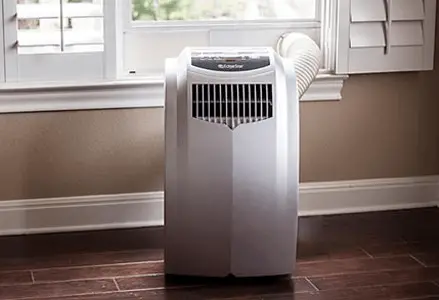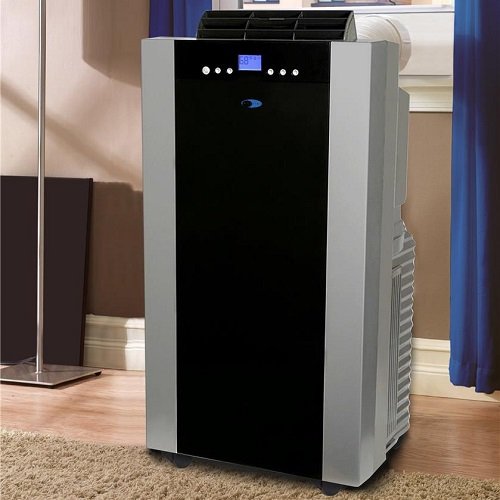Energy efficiency is a big topic these days, and rightfully so.
The move towards energy efficiency has been trending for both environmental and financial reasons.
In order to help consumers make sense of this, the US, UK and other governments have developed country-specific energy efficiency ratings (EER) for most major electric appliances, including portable air conditioners.
In this guide you will learn about the US standard rating system and how to use it when purchasing a portable AC in the US.
NOTE: If you are still searching for a portable AC for your home, then check out our updated list of the best portable air conditioners selling right now:
Best Portable ACs of 2020
See our top picks for every size room and budget - with reviews, pros/cons, buying tips & more!

Portable air conditioners are usually listed online and in stores with their energy efficiency rating, or EER, clearly displayed.
The EER of an air conditioner is easy to calculate, but there are a few terms and measurements you need to understand before doing so, so we’ll cover them first.
BTU
Calculating energy efficiency for a portable air conditioner involves first knowing the BTU rating. BTU stands for British Thermal Unit, which is a way of measuring a portable air conditioner’s cooling output.
At its core, BTU represents the amount of energy needed to raise the temperature of 1 pound of water 1°F. In the case of a portable air conditioner, it refers to how many BTU’s per hour the unit can remove from the air around it inside a space, which is how the space is cooled.
A portable air conditioner with a high BTU amount is intended for use in a large area. Lower BTU units are for smaller rooms. Using a unit with the incorrect BTU amount will result in a room not cooled properly, whether you are using too big a size or too small.
Determining The BTU Amount You Need
There is a simple method for calculating your own BTU needs.
An air conditioner needs approximately 20 BTU for each square foot of the space you are going to be using it in most often. Measuring the square footage can be done by multiplying the length of the room by the width.
For example, here are three standard room sizes, and the corresponding BTU amount needed to cool it properly -- and efficiently.
- 300 square feet or less = 10,000 BTU
- 500 square feet = 10,000 - 14,000 BTU
- Over 500 square feet = 14,000+ BTU
Additional room characteristics such as ceiling size, sunlight amount, and any appliances giving of extra heat on a regular basis will need to be taken into consideration as well. Increase the BTU amount by 10% depending on these variables. We go over all of this in more detail here (link to Article 1)
So, now that you know what BTU is, it’s time to move on to the next term to know before calculating EER.
Wattage
This is pretty self-explanatory. Wattage, by definition, is a way to measure power, or the amount of power required to operate an electrical appliance or device. Wattage amounts on a unit are indicative of how many watts they consume when in use.

The less wattage used, the less energy used. So, in turn, you want a unit that will offer the best amount of BTU’s, while using the least amount of wattage in doing so.
Do The Math (It's Simple)
Now that you know the terms, it’s time to learn how to calculate EER.
A portable air conditioner’s energy efficiency rating is its BTU rating over its wattage consumed. You divide the BTU amount by the wattage.

Example: A 12,000-BTU portable air conditioner consumes 1,400 watts, so its rating is 8.5 (12,000 BTU/1,400 watts).
The higher the resulting rating is, the more energy efficient the unit is going to be. These ratings are listed on the Energy Guide label found on all applicable products.
Why Energy Efficiency Ratings Matter
If you’re trying to lower your bills, the energy efficiency rating of your portable AC is really important.
As a whole, people in the United States spend over $11 billion annually to cool their homes, and that’s with just over 2/3rds of the country even having air conditioners.
So if you care about being green or saving on your utility bills, then you should always try to find appliances and devices that are as energy efficient as possible.
Reducing the load on your local power grid is beneficial to the environment, and can certainly add up over time in a good way.
While central heat and air units are more energy efficient overall, they can still run up your bills if they are constantly run to keep the home cool. If you don't use all of your home anymore, portable air conditioners can be the greener solution.
Another way portable ACs can help cut utility costs: Different parts of your home may have different cooling needs, depending on where they are and what they are for.
Let’s say you have a certain room in the home that has more windows, or is warmer due to having certain appliances constantly running. You are are relying on the bleedover from the air conditioning in the rest of the home to trickle over to that particular room.
This means you are turning the thermostat down to keep the central air on longer, just to cool down one room.
The end result is higher bills, and parts of the home that are uncomfortably cold, just to get that one room down to a desired level.
How a High EER Portable Air Conditioner Helps
With a portable air conditioner you can target that one room or area specifically, cooling it down to a desirable level, while the rest of the home remains the same. You get a cooler room, a more comfortable home, and lower bills.
The lowered bills aspect is made even better when using a unit that has a higher energy rating. The unit may cost more initially over a model with a lower rating, but you’ll end up saving money over the long run, making it all worth it.
Overall, a portable air conditioner can usually help your bills no matter what its rating is when used properly, but the higher EER model is going to save you even more.




